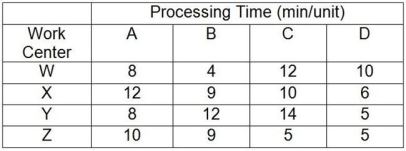Table 5.2
A company makes four products that have the following characteristics: Product A sells for $75 but needs $20 of materials and $20 of labor to produce; Product B sells for $90 but needs $45 of materials and $20 of labor to produce; Product C sells for $110 but needs $50 of materials and $30 of labor to produce; Product D sells for $135 but needs $75 of materials and $40 of labor to produce. The processing requirements for each product on each of the four machines are shown in the table.

Work centers W, X, Y, and Z are available for 40 hours per week and have no setup time when switching between products. Market demand is 50 As, 60 Bs, 70 Cs, and 80 Ds per week. In the questions that follow, the traditional method refers to maximizing the contribution margin per unit for each product, and the bottleneck method refers to maximizing the contribution margin per minute at the bottleneck for each product.
-Use the information in Table 5.2. Using the bottleneck method, which product should be scheduled first?
Definitions:
Breach Of Warranty
The violation of a promise or guarantee made about the quality or condition of a product or service, which can give rise to legal action for damages.
Theory Of Liability
The legal concept or basis upon which a party can be held accountable for a wrong or damage in a lawsuit.
Restatement (Third) Of Torts
A compilation by legal scholars summarizing the common law of torts in the United States, aiming to clarify principles and rules.
Strict Liability
A legal doctrine that holds an individual or entity responsible for their actions or products, regardless of fault or intent, particularly in cases of harm or damage.
Q22: Explain why a bottleneck limits system output.
Q35: Which one of the following statements about
Q36: Takt time is the cycle time needed
Q48: Using Table 7.14, what is the probability
Q56: The just-in-time (JIT) system is a(n):<br>A) management
Q61: The production of 150 units during a
Q74: Output measures are used for estimating capacity
Q92: A line balance that is 100% efficient
Q115: Use the information in Figure 5.3. How
Q140: Which of the following would be considered